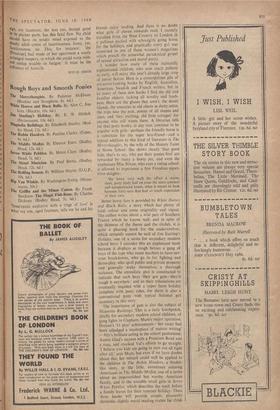Going Berserk
The Bombard and Viking's Sunset. By Henry Treece. (Bodley Head, 12s. 6d. each.)
The Blood Red Crescent. By Henry Garnett. (Bodley Head, 12s. 6d.) The Adventures of Ulysses. Told by Jacques Le Marchand and illustrated by Andre Fran- cois. (Faber, 15s.)
Ma. HENRY TREECE is a good and practised hand at writing historical stories for children, his favourite periods being Romano-Celtic and Saxon times, though in The Bombard, which we have here, he conies up to the fourteenth century. Under review also is his latest book, Viking's Sunset, last of a trilogy His method is to write straightforwardly, without affectation, and to strike home with a quick thrust of imagination. For instance, when his Vikings are enjoying a rare smooth patch in mid-North Atlantic, he says the sea is `a sheet of glass as broad as the world, as muscular as a giant's flank.' He also has the good habit of writing a brief foreword called `About this Book' which gives the reader a firm background note. There is no harmful cruelty in his books, though there is much bloodshed and tension. I should like to read an older book of his called The Children's Crusade, if only to see how he avoids harmful cruelty in a matter so full of it. Children could hardly bear the full account of this glum event.
To come now to his new books. The Bombard is the story of an Anglo-Welsh boy from an impoverished Border family, loyal. to Edward III, but in some difficulties with a nasty neighbour in a Norman stronghold, and with the revolting (in the military sense) Welshmen. The boy David takes service under Edward and his ferocious son, who is thus pictured : The face of the fifteen-year-old Black Prince was one to marvel at. His once fine nose had been broken and set askew . . . his mouth was drawn down at the left corner by a livid white scar. and when he smiled David could see that the teeth on that side had been knocked out . . . the top of his right ear had been shorn across.
Help! This charming child's chief passion is for a sort of proto-howitzer called a bombard. David is put in charge of bombards and helps to win the battle of Crecy. He then hauls one of them back to England with him and blasts the Border castle and their nasty neighbours to rubble. At which point he repents and leaves gunnery for the Church . . . a not quite plausible conclusion. Viking's Sunset is about the supposed voyage of the Viking Sigurdson and his supporters from Norway by way of Iceland and Greenland to the New World and is dedicated to an American boy who told the author that a longship prow had been found in one of the Great Lakes. The author catches the saga-feeling very well and also the mixed Viking characteristics of jolly roving, dash, pluck, seamanship and fireside tale- telling. He gives a particularly fine description of Vikings going berserk. Brotherhood between Northmen, Eskimos and Red Indians finds a loyal place---a shade slippery perhaps—and the villain of the piece, maimed, resentful and mur- derous, is understandable. Everybody in child- ren's adventure stories seems like little boys . . . perhaps they were.
This thought stems also from The Blood Red Crescent by Henry Garnett, a rousing tale Of tie Battle of Lepanto and the part played in it It), a young Venetian boy and his English RI' friends. The Crescent manages to capture one or two of the ladies, in a cut-and-run coastal raid, but the Cross releases them This book, rather oddly, and at the end instead of the beginning. carries the nihil obstat and imprimatur of the Catholic Church. The Flying Ensign, by Showell Styles, conies nearer our own times. being the adventures of a young lad from Cumberland °I the armies of Sir John Moore, in and out of the fearful retreat over the mountains to Cornn°a . and in that battle's victorious outcome. It I' excellent for its true army feeling and the pieturdc it gives of dubious allies, harsh travelling an the young hero's fear of being afraid Rifles li1.1 Watie is about the American Civil War. Thil young hero, Jeff Bussey, enlists in the Federa' Armies, goes as a spy to the Confederates, where he serves under the famous Red Indian rebel leader Watie, and suffers besides the onslaughts, of the enemy, the neurotic hatred of his own CO. Mr. Keith gives a fair and living picture 0 this disastrous war and of the human feelings involved. The book took a high prize in America' The Iliad of Homer, told by Barbara Lennie Picard and beautifully illustrated, is a little 0° the sombre side. One misses Homer's sardonic way with gods and mortals, in his squabbling scenes on Olympus, for instance, and on the battlefield, when Diomed sends Aphrodite run: ning home to heaven to bewail her horrid'} scratched wrist. Why can't children just read Mr' Rieu's glorious Penguin translation? Of rite Adventures of Ulysses] can only say, How livelY' and how horrible. The trouble is its facetious' ness. The drawings, splendid in colour and de' sign, are facetious; the text too, though good In its plainer parts, has this fatal flaw. No child should have its tender mind exposed to the deadly adult crime of facetiousness. Irony, yes, facetiousness, no. This, for instance: 'she [Penelope] had made of her apartment a neatly arranged weepery. in which she could weep with- 910 undue trouble or fatigue.' It must be the Influence of Anouilh.
STEN. Ili SMITH











































 Previous page
Previous page